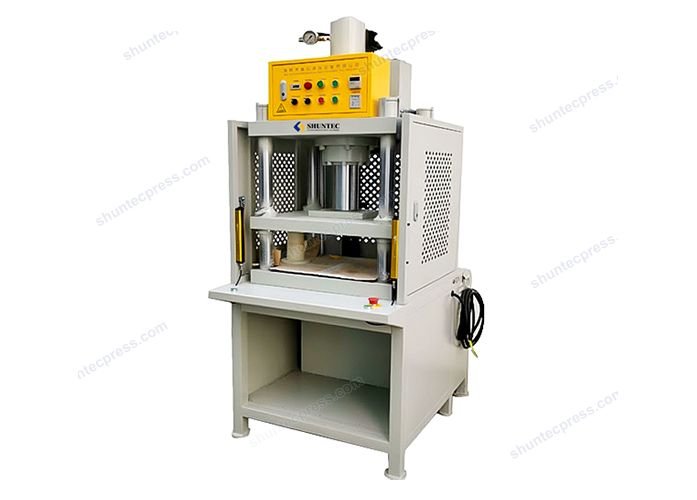
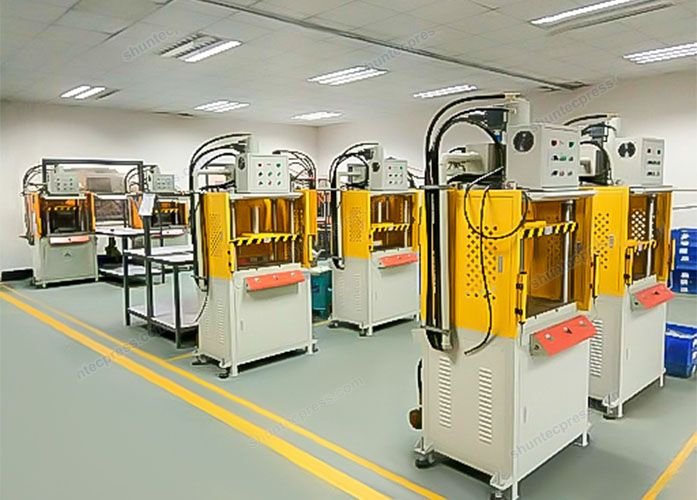
Advantages Of The Hydraulic Press
(1) Since oil is generally used as the transmission medium, the hydraulic components have good lubrication conditions. the working fluid can be transported to any position through the pipeline, allowing a certain distance between the hydraulic actuator and the hydraulic pump. A hydraulic control system can easily change the rotational motion of the prime motor into linear motion.
(2) A wide range of step-less speed regulation can be realized during operation.
(3) The hydraulic press is easy to realize load control, speed control, and direction control, and control methods include centralized control, remote control, and automatic control.
(4) The movement inertia is small and the response speed is fast.
(5) The hydraulic press machines are widely used for both heavy-duty and light-duty applications.
Disadvantages Of The Hydraulic Press
(1) The overall efficiency is low.
(2) The performance and efficiency of the transmission system are greatly affected by temperature.
(3) The liquid has a certain degree of compressibility, and there is inevitable leakage on the mating surface, so a strict transmission ratio cannot be guaranteed for hydraulic drive.
(4) The working fluid is very sensitive to pollution, and the contaminated working fluid is very harmful to the hydraulic components. Therefore, troubleshooting of hydraulic systems is difficult and has higher requirements for the technical level of the operation and maintenance personnel.
(5) Hydraulic components have relatively high requirements for manufacturing precision, surface roughness, material, and heat treatment, so the cost is relatively high.
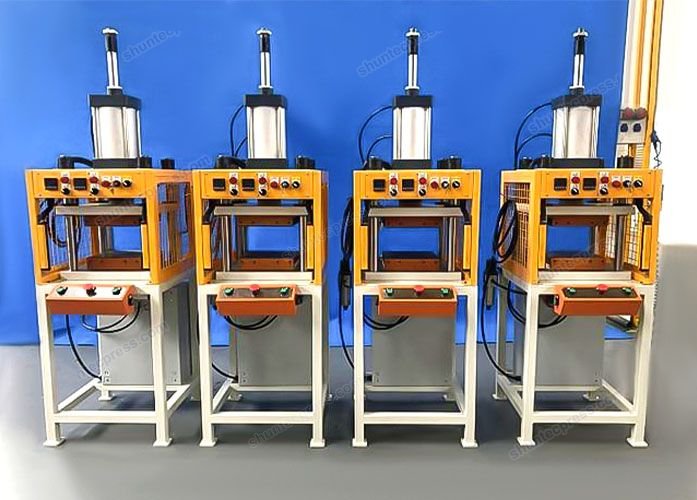
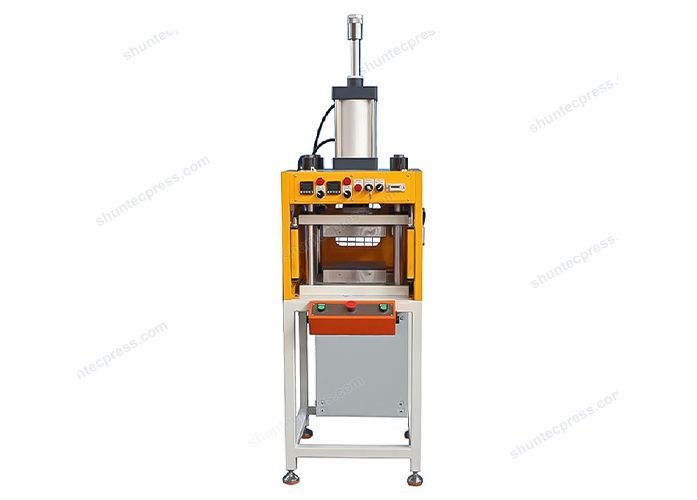
Advantages Of Pneumatic Press
(1) Air source is very convenient. The air can be exhausted directly after use. There is no pollution in the process.
(2) Because air viscosity is small, the friction force during gas transmission is also small. Therefore, the air can be supplied centrally and transported over a long distance.
(3) Pneumatic press has good adaptability to the working environment. Especially in harsh working environments such as flammable, explosive, dusty, strong magnetism, radiation, vibration, etc., it has a higher degree of safety and reliability than hydraulic press and electric servo press.
(4) Pneumatic action is rapid, quick response, and can be adjusted conveniently. Automatic control can be realized by air pressure signals.
(5) The pneumatic components are featured by simple structure, low cost, and long service life. It has an automatic protection mechanism that will be activated under overloaded conditions. It is easy to standardize, serialize and generalize.
Disadvantages Of Pneumatic Press
(1) The stability of working speed is poor.
(2) The output force or torque of the pneumatic press machine is small when working pressure is low (0.3~1 MPa).
(3) The air purification process is more complicated because impurities and water vapor in the gas source must be purified.
(4) Due to the low air viscosity and poor lubricity, a separate lubricating device is required.
(5) There is a loud noise in the air exhaust process.

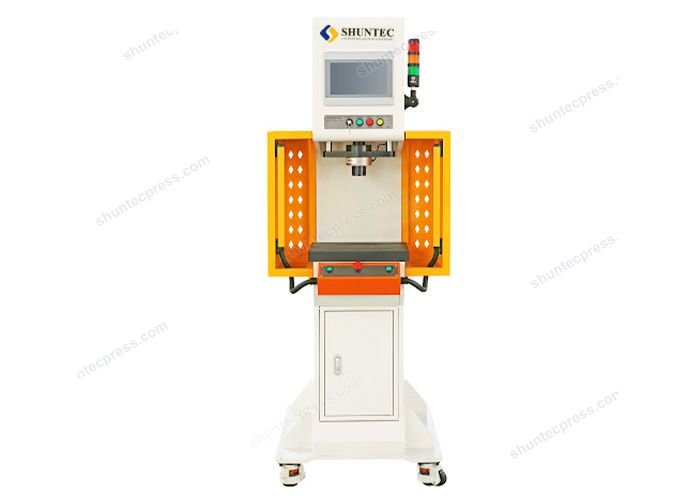
1. High Accuracy
Servo motor is used as a power source. The transmission mechanism is composed of a ball screw and a synchronous belt and is very simple and highly efficient. The repeat accuracy error is 0.01%.
2. Energy Saving
The energy released during the deceleration phase of the working cycle can be converted into electric energy for reuse, thereby reducing operating costs.
3. Precise Control
Electric servo press can realize precise control according to the set parameters. With the support of high-precision sensors, metering devices, and computer technology, it can greatly exceed the control accuracy that can be achieved by other control methods.
4. Improve The Level Of Environmental Protection
due to the reduction of the energy used and the optimized performance of the electric drive, the pollution sources are reduced and the noise is reduced, which provides a better guarantee for the environmental protection work of the factory.
5. Reduce Noise
The operating noise value of an electric servo press is less than 70 decibels and is about 2/3 of the noise value of a hydraulic press machine.
6. Cost Saving
electric servo press is exempt from the cost and trouble caused by the hydraulic control system because there is no hard pipe or hose required, and no need to cool the hydraulic oil.
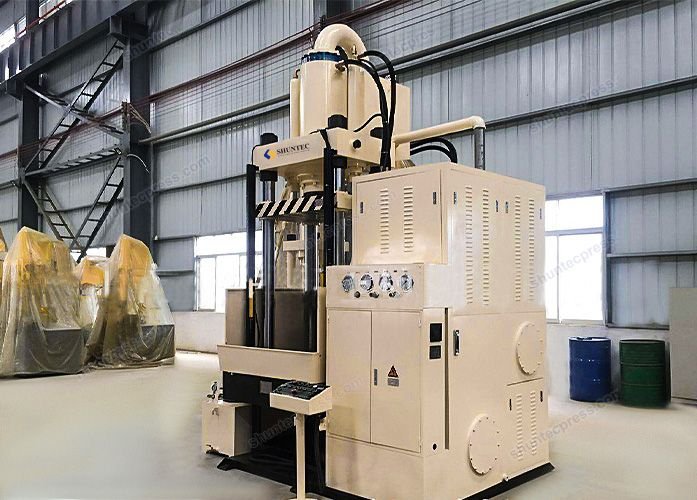

Hydroforming hydraulic press is a kind of metal forming press machine that uses fluid as the working medium to produce defined sizes and shapes. During the forming process, high-pressure fluid is used to generate pressure against the interior wall of the tube. Since the tube is sealed at both ends by a punch, and materials are supplemented to the tube, the pressure inside the tube is kept at a high level and forces the outer wall of the tube to completely match the mold cavity, and in this way, the intended shape is obtained.
Compared with traditional farming methods in which two-part halves are stamped and welded together, the hydroforming process can produce parts with high integrity, which means that the parts can be formed one time, and requires no or little subsequent welding procedures. It is also because there is no need for welding, the parts produced by hydroforming are of seamless bonding, which can achieve higher strength and better surfaces of the finished products. Besides, parts produced by hydroforming are lightweight. Compared with traditional metal stamped and welded parts, the weight of hydroformed parts can be reduced by 20% to 30%. Due to the one-time forming ability, work time and labor force can also be reduced significantly, which ultimately increases productivity.
Due to its various advantages, hydroforming hydraulic press has been used in the automotive industry, plumbing and heating industry, household appliance industry, aviation, and aerospace industry, etc.
Specifically, hydroforming technology is applied to water bulging hydraulic presses. This kind of press is highly capable of forming hollow complex-shaped components with integral structures.
Features Of Water Bulging Hydraulic Press
1, Working speed is fast and efficiency is high, whereas the energy consumption is low.
2, By virtue of sophisticated designs, the press can achieve high working pressure. Under high working pressure, the press can guarantee clear texture and thereby improve the appearance and quality of the finished products.
3, The press is equipped with a movable slide table, which makes it very convenient to load and unload materials. With this table, the height of the machine can be effectively reduced, and a high level of stability and reliability of the machine can be improved.
4, The press can realize the function of material withdrawal and material feeding, and improve the bulging limit of materials. Due to the bigger bulging limit, the press is especially suitable for the hydroforming of complex parts.
5, The hydraulic system is controlled by two-way cartridge valves, which can guarantee that the pressure loss is small and action is stable and reliable.
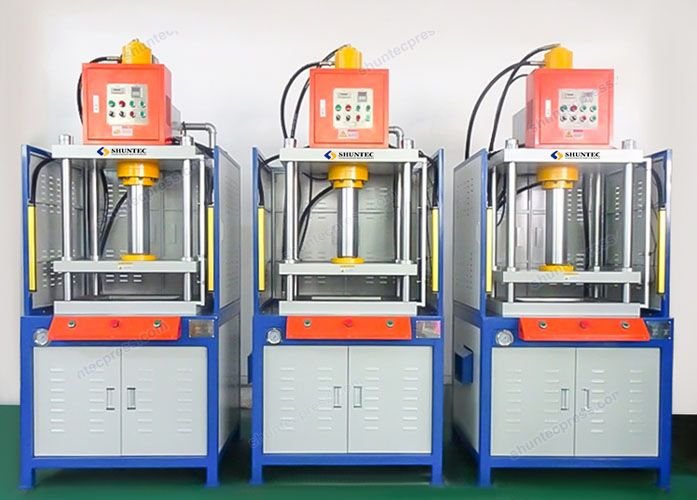

The four-column hydraulic press drives the operating mechanism by the motor through the transmission mechanism, applies pressure to the workpieces, and completes its processing process. The transmission mechanism is a reduction mechanism driven by a belt or gear. The transmission mechanism is a belt-drive or gear-drive decelerating mechanism; the operating mechanism is divided into a screw mechanism, a crank connecting rod mechanism, and a hydraulic cylinder. The transmission mechanism of a hydraulic press can not only complete various forms of complex motion and compound motion but also complete a large-scale continuous step-less speed regulation. Now let’s have a look at the issues that should be paid attention to when adjusting the pressure and reducing vibration of the press.
Pressure Adjustment Of four-Column Hydraulic Press
The pressure of debris cannot be higher than the pressure of the pump unless the hydraulic machine has a supercharging device. The actual pressure of the pump depends on the load size and is generated automatically rather than adjusted. The set pressure of a four-column hydraulic machine is the maximum pressure for normal operation. Lower the pressure of the overflow valve, adjust the overflow valve, and the pump outlet pressure will rise to the required value.
Vibration Reduction Methods Of Four-Column Hydraulic Press
After the four-column hydraulic press is used for a period of time, every time it starts or stops, there will be the vibration of the machine with noise. This is not good for the hydraulic press in the long run; it also affects the production efficiency and causes concern for the operator. Therefore, we
have to think of some methods to reduce the vibration.
The vibration caused by the alternating internal and external cycles of the hydraulic press process system, also known as forced vibration, is mainly caused by external interference. The vibration source must be eliminated first. Prevent the exciting force frequency of the four-column hydraulic press from approaching the natural frequency of the system to avoid resonance. the motor speed is changed or the spindle speed is changed to avoid resonance. Adopt the forward contact surface accuracy, reduce the roughness of the joint surface, eliminate the gap and the forward contact stiffness, which can eliminate vibration.
The Vibration Isolation Method Can Be Adopted To Reduce The Vibration Of The Four-Column Hydraulic Press
The motor and the bed can use flexible connections to isolate the vibration of the motor itself. the hydraulic buffer device can be used to reduce the shock when the components are reversed. thick rubber and wood can be used to isolate the machine from the foundation; consider using anti-vibration ditch separation equipment connected to the ground to prevent the surrounding vibration source from being transmitted to the hydraulic press through the ground.
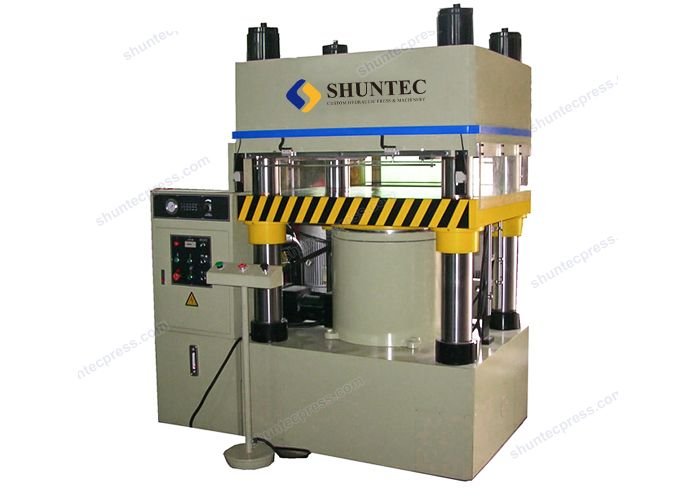
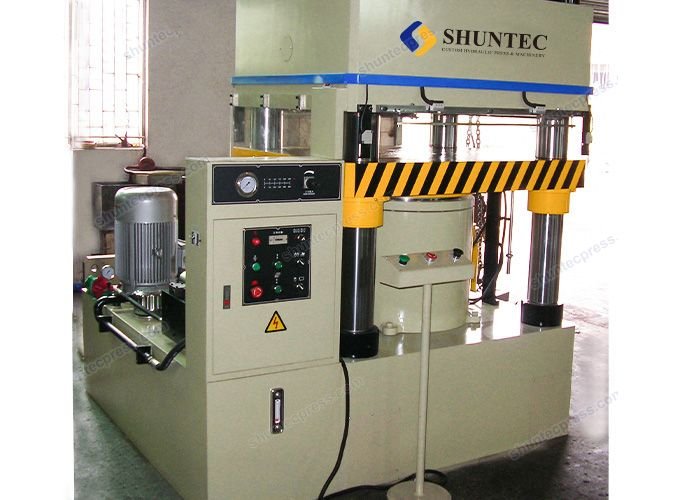
Die-cutting is the process in which a die is involved to shear or cut materials into the size and shape as determined by the die. Generally speaking, Applicable materials for the die-cutting process are low-strength materials, such as rubber, paper, paperboard, plastics, sheet metal, etc. The die-cutting press was first invented to address the issue of cutting leather for the shoe industry in the mid-19 century. In modern times, die-cutting has become a very typical post-processing procedure for printing materials.
In addition to printing materials, a die-cutting press machine is also often used for producing jigsaw puzzles. Jigsaw puzzles are produced by cutting pieces of wood or cardboard which are painted with a drawing into small pieces with intended sizes and shapes, and then people put these small pieces together to restore the original picture. Jigsaw puzzles inherently have higher requirements for the quality of cutting. Good-quality cutting should take out very little wood or cardboard so that the pieces can fit together well, otherwise, there will be too much gap between pieces. Besides, well-cut pieces should have a very smooth edge surface with minimum chipping.
In order to meet the above-mentioned requirements, a jigsaw puzzle dies cutting press machine has appeared accordingly. Jigsaw puzzle dies cutting press machine can be regarded as one of the most wonderful applications of the die-cutting process. This kind of machine can produce very intricate puzzle pieces with good quality and high precision. When combined with a hydraulic system and servo system, it can achieve even higher efficiency and productivity.
In real practice, a jigsaw puzzle cutting machine is usually combined with a jigsaw puzzle scattering machine and puzzle bagging machine to form a complete puzzle production line. Customers can decide whether to procure one machine or the whole production line according to actual needs.
Features Of Jigsaw Puzzle Die Cutting Press Machine:
1, The machine adopts a 4-post column structure which can achieve super rigidity and precision bed-to-ram parallelism and thus guarantee good cutting quality.
2, The machine can achieve fast approaching, pressing, and returning speed so that the productivity is high.
3, By virtue of its sophisticated designs and good quality materials used, the machine can not only achieve high work efficiency but needs little maintenance throughout the entire lifetime. This is very meaningful for manufacturers who are often annoyed by machine breakdowns from time to time.
4, The machine is equipped with a central color touch screen through which all parameters can be easily programmable.
5, The machine can achieve good quality cutting effect with a very smooth edge surface and minimum chipping. This can be the most noticeable feature that influences the manufacturer’s purchasing decision for the machine.
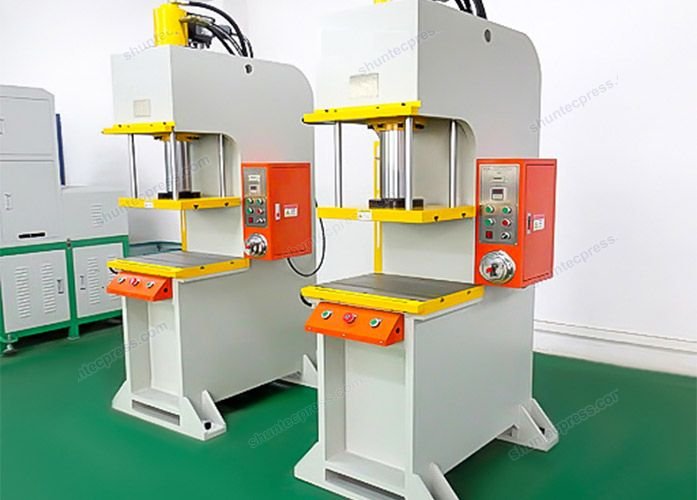

C frame hydraulic presses play different roles for different products. For shaft parts, profiles, etc., the C frame hydraulic press is mainly used to complete the pressing of the parts; for metal materials, it is mainly used for the stretching, blanking, bending, flanging, correction, pressing, and cold & hot extrusion of the material. It is also indispensable for compression molding of such products as powder products, plastic products, etc. How much do you know about the application and features of C frame presses? Let’s take a look!
Application Of C Frame Hydraulic Press
1. The C frame hydraulic press is mainly used for correction and press-fitting of shaft sleeve parts, and can also be used for other processing purposes.
2. As the C frame press stands upright, and its equipment parts are inside the machine body, the appearance is neat and beautiful.
3. The C frame hydraulic press can be used for handle and pedal operation. The pressure of the hydraulic press can be adjusted within the specified range. The stroke can be controlled with a relatively simple operation.
Three Features Of C Frame Hydraulic Press
1. The integral welded solid open structure of the press can keep the body rigid enough while having a convenient operating space.
2. The press has noticeable advantages such as good structural rigidity, good guiding performance, and fast speed, etc.
3. The convenient manual adjustment mechanism of the press can adjust the position of the pressure head or can press any position in stroke, and it can also arbitrarily adjust the distance of fast forward stroke and pressing stroke。
The C Frame Press Has Strong Versatility
It’s optional to have an additional pressure sensor to convert into a press-fitting force value and display it digitally through data acquisition and system processing composed of the PLC. When the force exceeds the limit, it will send out sound and light alarm and shutdown signal, so as to achieve automatic control of press-fitting force. The load display controller can control the value accurately and display it clearly; it has fast response speed and stable and reliable working conditions. Different sensors and application software can be replaced for different forging equipment with different tonnages. By using a counter, every operator knows the total number and the unqualified number. And the two-hand start button is added to make the operation of the machine safer.


For metal processing, in addition to routine processes such as heat treatment, press-fitting, compression, etc., there is another indispensable procedure that is called straightening. Straightening can eliminate or reduce deformation of the components, improve uniformity and create better geometry.
Importance Of Hydraulic Straightening Press
Nowadays, with higher and stricter requirements for components and end products in uniformity, geometry, accuracy, and cost-saving, hydraulic straightening presses have been more and more widely used by manufacturers who intend to improve productivity while saving costs. Hydraulic straightening presses are particularly useful for shafts, plates, and large weldments. Machining, heat treatment, and forming can cause these kinds of workpieces to warp or deform. Manufacturers have to remove or reduce such deformation before moving on to the next production steps. Especially for shafts, which are more complicated and have diversified sizes, it is barely possible to automate the straightening process, so a (hydraulic) straightening press is required.
Features Of Numerical Control Hydraulic Straightening Press
Even though an ordinary straightening press can also achieve the purpose of straightening, but it has a lot of unavoidable functional limitations. In order to increase the performance, an ordinary straightening press can be upgraded to include other functional systems or units, such as numerical control systems and hydraulic systems. A numerical control hydraulic straightening press has the following noticeable features:
1. Through the computer programming system, this press can accurately set the stroke of the indenter, effectively control the pressing distance, and avoid repeated straightening, which greatly improves the work efficiency and the straightening accuracy. The machine tool has an independent power mechanism, hydraulic and electrical systems, and its working pressure, pressure correction speed, and stroke range can be adjusted.
2. The stroke of the indenter can be numerically controlled and displayed, and the "0" point can be set arbitrarily.
3. Manual and automatic operation modes are available to choose from. Or the straightening distance can be controlled by the real-time display of the indenter stroke in the slow state.
4. The curvature of the workpiece straightened by the machine is not more than 0.02mm within the full length, and there is no crushing mark on the surface.
5. In the automatic state, the acceptance range of the shaft can be set. If the acceptance range is not reached, the indenter can be automatically straightened the workpiece until it reaches the said range.
Comparison Between Ordinary Straightening Machine And CNC Hydraulic Straightening Machine
1. Ordinary straightening press uses dial indicator to detect the accuracy, and it is not controllable, whereas the accuracy of CNC hydraulic straightening press is detected by the high-precision sensor and can reach 0.001mm.
2. The threshold for ordinary straightening machine operators is high with many years of work experience required. By comparison, CNC hydraulic straightening press can automatically complete the straightening of workpieces, and no working experience is required for the machine operators.
3. Working efficiency of the CNC hydraulic straightening machine is much higher than the ordinary straightening machine.
4. Ordinary straightening machines adopt manual quality inspection, and CNC hydraulic straightening machine adopts computer-automatic quality inspection.
5. Ordinary straightening machine controls the indenter manually, and it is difficult to control the accuracy by human experience. As for CNC hydraulic straightening machine, the pressing stroke is automatically calculated and controlled by a computer and the accuracy can reach 0.01mm.
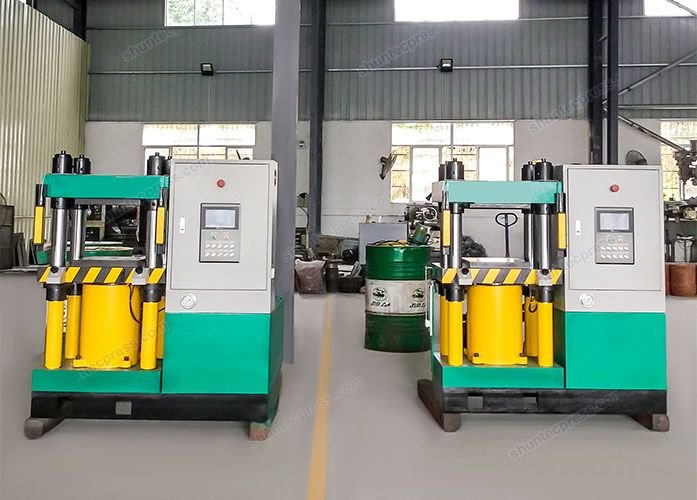
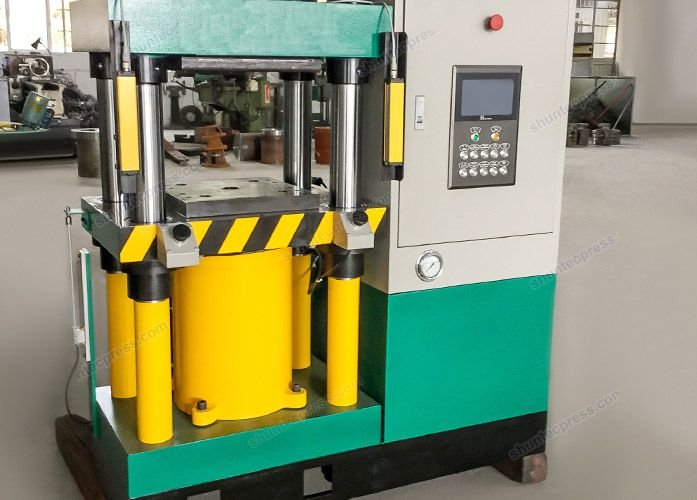
1. The Main Oil Pump Of The Hydraulic Press Is Directly Driven By A Servo Motor To Realize Energy Saving
At present, there are still many difficulties in the direct drive of hydraulic pumps by high-power servo motors. The main reason is that the speed range of the hydraulic pump is very large. The minimum speed of the general hydraulic pump is 600 r/min, and the hydraulic pump can work normally even if it is below 10 r/min.
High-power AC servo motor and its control technology
The advent of high-power AC servo motor is a new product which came into being in the past 10 years. At present, the technology mainly adopts switched reluctance motor (SMR), SMR is well known as being simple and reliable, and it also has other noticeable advantages including high-efficiency operation in a wide range of speed and torque, four-quadrant operation, fast response speed, and low cost. But it also has disadvantages which include high control costs and low power density due to the system’s nonlinear characteristics, large torque fluctuations, and large vibration, etc.
The AC servo motor drive control unit is composed of large-scale integrated circuits, high-power rectifier modules, and other electronic power components. With the development of electronic technology, the performance of high-power AC servo motor drive control units has been improving, while the prices have been decreasing, which facilitates the realization and promotion of high-power AC servo drive technology, and makes it possible to adopt AC servo drives in the field of forging equipment. The focus of the research is to pull scientific research energy to develop high-power AC servo motor control technology and related application technologies with independent intellectual property rights, which will provide a solid foundation for the development of servo-hydraulic presses.
2. The Closed-Loop Control Of Hydraulic Pressure And Position Is Realized By Changing The Speed Of The Servo Motor
The closed-loop control technology of hydraulic pressure and position through servo motor is not mature yet. Traditional hydraulic presses control hydraulic pressure and position through proportional valves and proportional servo valves. It is necessary to study a special control algorithm to achieve the high stability and high accuracy of hydraulic pressure between 1 and 25 MPa.
3. Research On Energy Recovery And Energy Management Systems
In order to save more energy and reduce energy loss as much as possible, it is necessary to recover and reuse the potential energy of the sliding block's own weight and the energy generated by the pressure relief of the oil cylinder. Currently, there is no mature practice and experience in this regard yet. In terms of energy management, since instantaneous power is many times larger than average power, energy must be deployed properly in large-scale servo-hydraulic machines to avoid impact on the power grid.
4. Research And Development Of Dedicated Control System
Most of the existing hydraulic presses are controlled by PLC, but the servo-hydraulic presses are controlled by hydraulic pressure and speed closed-loop program, which requires a large amount of calculation, so ordinary PLC can hardly meet the needs. Therefore, the control system of the servo-hydraulic press is controlled by an industrial PC, and a special control system must be developed.
5. Forming Process Optimization Of Servo-Hydraulic Press
Since the materials and shapes of different kinds of stamping parts are different, the stamping processes are also different. As for the silent blanking process, for example, the control of the shifting point is the key; in reverse extrusion forming of the magnesium alloy cup-shaped part, the slider needs to experience 4 different speeds in a working cycle, and the extrusion process is under constant- pressure control. Therefore, only when the servo-hydraulic press is optimized in combination with various forming processes, can it exert its superiority. To achieve the goal of improving product quality and production efficiency and reducing production costs, it is very important to study the forming mechanism of various forming processes and establish optimized parameters suitable for each forming process.
6. Optimal Design Of Servo-Hydraulic Machine Body
Compared with traditional hydraulic presses, servo-hydraulic presses have more advantages such as energy-saving and noise reduction. When designing their machine body, more factors need to be considered so as to achieve these advantages, such as various possible extreme working conditions, working frequency, and the complexity of stamping parts, etc. For a long time, Chinese engineers and technicians have mainly adopted empirical methods and analogy methods when designing products, and the forging machine tools have disadvantages such as large volume, heavyweight, and poor control accuracy, etc. Steel consumption has been one of the key factors in product cost control for forging machine tool manufacturers.
Through a lot of efforts, Chinese scholars and engineering technicians have developed relevant optimization software for partial optimization of forging machine bed components. However, they have been mainly lingering in the static design stage, and have not considered much of the dynamic machining process of the machine tool system. Therefore, the corresponding issue of machine tool reliability has not been fundamentally solved, resulting in a reduction of the service life of the machine tool and an increase in the maintenance cost of the machine tool. Therefore, it’s imperative to form a design method and technical system under the constraints of the rigidity, strength, and dynamic performance of the forging machine tool, so as to narrow the gap between our own country and developed countries in the design and manufacturing of products.
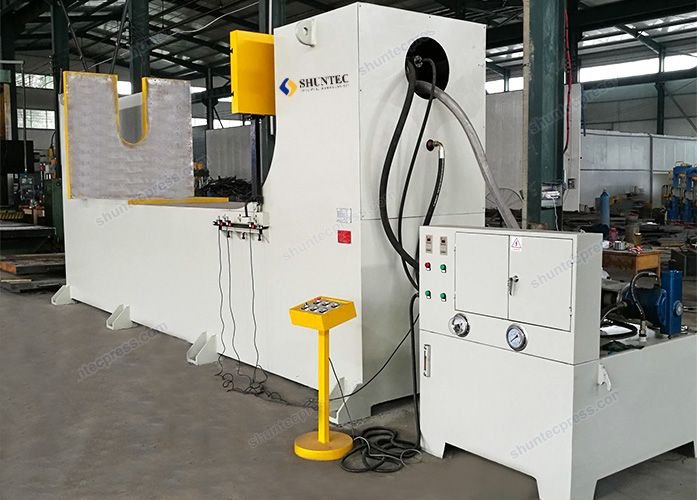
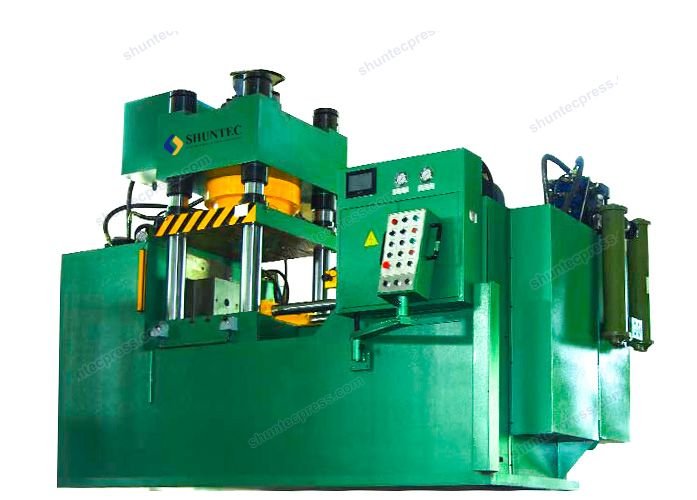
In terms of structure, hydraulic presses dominantly adopt the vertical style, and the oil cylinders move up and down to perform the job. However, vertical hydraulic presses are not always omnipotent. For certain kinds of parts which is too long, it is very difficult to load into a vertical press. In this case, a horizontal hydraulic press is highly preferred.
A Horizontal Hydraulic Press Is A Kind Of Press Machine That Adopts A Horizontal Construction Structure
The cylinder of the horizontal hydraulic press performs left and right reciprocating actions in the horizontal direction, as opposed to the vertical up and down reciprocating action of a vertical hydraulic press oil cylinder. In terms of structure, it can be regarded as a lying-down 4-column hydraulic press or C-frame hydraulic press. Actually, the common structures of the horizontal hydraulic press are quite similar to those vertical structure hydraulic presses, including four-column and three-plate, C frame structure, and so on.
Because of its lying-down structure, manufacturers’ plants don’t have to be very high to accommodate a horizontal hydraulic press, but this kind of machine takes up a larger footprint than vertical hydraulic presses. Besides, the position of the oil tank, main cylinder, and part of the valve body is also much lower than that of the vertical hydraulic presses, which makes it much more convenient to examine and maintain the machine. Horizontal hydraulic press shares a lot of common applications with a vertical hydraulic press, but due to its lying-down position, it is mainly used for the press-fitting process of large and long shaft sleeve parts, such as press-in of the motor stator, press-in of the motor rotor shaft, and bearing, etc.
Characteristics Of The Horizontal Hydraulic Press
1, The press adopts the typical structure of four-column and three plates. The vertical precision of the left and right movable plates is controlled by eight precision guide bushes and the parallel precision of any point on the left working face and the right working face can reach within 0.08mm.
2, The press has comprehensive safety designs to guarantee the safety of the operators. It adopts a two-handed operation mode and is equipped with an emergency button. In case of emergency, the press can be stopped in order to cause any damage.
3, The worktable is equipped with a charging conduit and a blowing device to improve production efficiency.
4, Pressure, stroke, speed, holding time, closing height can be adjusted according to requirements, and the operation is very easy and convenient.
5, There are casters and foot cups under the workbench, which makes it easy and convenient to move.
Typical Applications Of The Horizontal Hydraulic Press
1. Automobile industry: press-fitting of engine components (cylinder heads, cylinder liners, oil seals, etc.), press-fitting of steering gear components (gears, pins, etc.), assembly of transmission shaft components, press-fitting of gearbox components, and press-fitting of brake disc components.
2, Motor industry: press-fitting of micro-motor components (spindle, housing, etc.), press-fitting of motor components (bearing spindle, etc.)
3, Electronics industry: Press-fitting of circuit board components (plug-ins, etc.), and press-fitting of electronic components.

